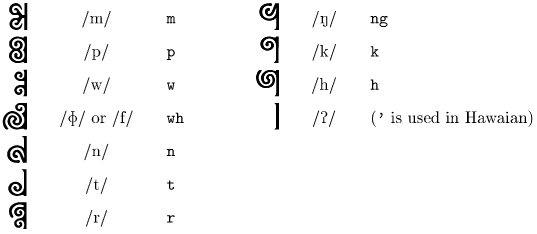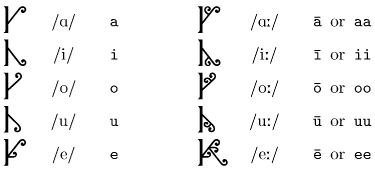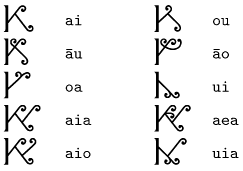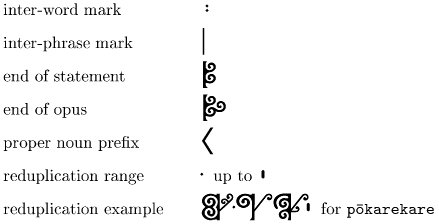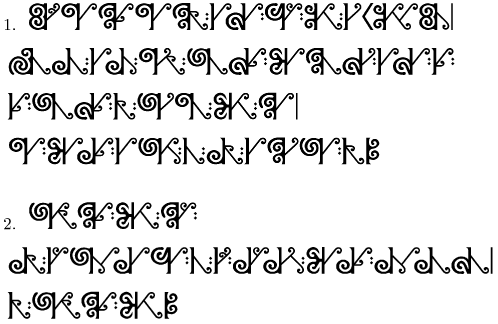The New Maori script is an alternative to the Roman alphabet normally used for the otherwise script-less Maaori language of New Zealand.
Part of the aim was to suggest a “formal” or “sacred” alphabet for the recording of special poems and songs, while maintaining a local aesthetic in the visual form. In the case of Maaori—unlike some languages given it by missionaries—the Roman system is quite effective. So New Maori does not offer benefits of efficiency, simply those of cultural identity.
It can be used to write the Maaori language spoken by the aboriginal population of New Zealand and the Cook Islands, and quite easily for Tahitian (using /w/ for /v/) and Hawaian (using /r/ for /l/).
There is now also an extended form of this script, with extra letters for the writing of non-Maaori words, called New Maori Extended.
Notable features
- The language is strictly syllabic, each syllable being of the form consonant + vowel(s).
- The number of consonants is small (11), but combinations of the 5 primary vowels are common.
- The script is based on key motifs found in traditional surface decoration and sculpture, things for which Maaori artists are renowned.
- Vowels are attached to the consonant, and combinations of vowels form a continuous sprouting pattern, moving to the right.
- The writing system is phonetically consistent.
- Ideally, a complete song or verse would be written as a single long band, perhaps to decorate a wall. The punctuation marks might then be in red.
Consonants
The consonants have a bold, almost solid form, with curling motifs present in both positive and negative space. The solidity reflects the consonantal effect, and the form itself can represent the mouth or origin of the syllable. It may be noted that similar forms can be found in the traditional chin tattoos of men and women.
For words which in Roman form begin with vowels, the glottal plosive is presumed to be the functioning consonant. The consonants are listed here with the international phonetic symbol and the usual romanization:
Vowels
The vowels are lighter in form, and are based on the common motif called koru (representing a young fern frond), and combinations of vowels form a sprouting or branching effect similar to that found in the family of designs called kowhaiwhai. They may also be seen as airy wisps of sound swirling from the mouth. There are 2 connection points and 2 forms of each primary vowel to allow appropriate connection. Except for long /e/, the long vowels have a small version of the main vowel tucked within. The forms are either upward or downward, in-curling or out-curling. Diphthongs and triphthongs are pronounced quite simply as sequences of 2 or 3 primary vowels. Vowels are given here with the glottal plosive (ie. in initial position):
Some examples of vowel combination:
Because of the similarity of the vowels to some traditional design patterns, elements of the latter may now appear to be spelling out continuous song!
Punctuation
Sample texts
Transliterations
1. Pookarekare ana ngaa wai o Waiapu;
whiti atu koe hine marino ana e.
E hine e hoki mai ra;
ka mate ahau i te aroha e.2. Haere mai raa
te aahuatanga i oo taatou mate tuatini,
e haere mai.
Translations
1. (A famous love song, first verse and chorus:)
They are agitated, the waters of Waiapu;
but when you cross over, girl, they will be calm.
Oh girl, return to me;
I could die of love for you.2. (A ceremonial greeting to spirits, sung by women:)
Welcome
to the representatives of our many dead,
welcome!
A version of this page can also be found on
Omniglot.
(You may like to offer motivation for further development :)

